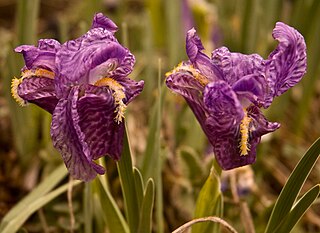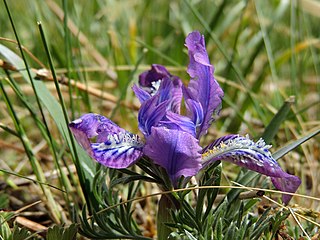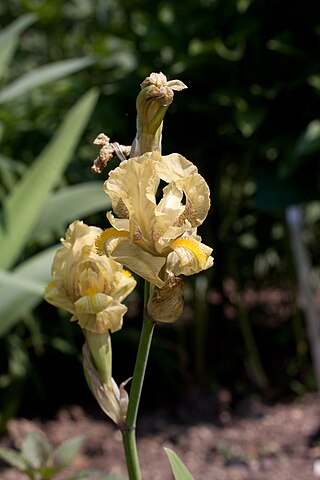
Iris spuria, or blue flag, is a species of the genus Iris, part of the subgenus Limniris and the series Spuriae. It is a rhizomatous perennial plant, from Europe, Asia and Africa. It has purple or lilac flowers, and slender, elongated leaves. It is widely cultivated as an ornamental plant in temperate regions and hybridized for use in the garden. It has several subspecies; Iris spuria subsp. carthaliniae B.Mathew, Iris spuria subsp. demetrii B.Mathew, Iris spuria subsp. maritima (Dykes) P.Fourn. and Iris spuria subsp. musulmanica (Fomin) Takht. It used to have 3 other subspecies, which have now been re-classified as separate species; Iris spuria subsp. halophila, Iris spuria ssp. sogdiana and Iris spuria subsp. notha . It has many common names including 'blue iris', 'spurious iris' and 'bastard iris'.

Iris milesii is a plant species in the genus Iris, subgenus Limniris and in the section Lophiris. It is a rhizomatous, beardless perennial plant, native to the Himalayas, India and China. It has pinkish-violet, or pinkish purple, or pinkish-lavender or pinkish lilac flowers, with a fringed yellow or orange crest. It is cultivated as an ornamental plant in temperate regions.
Iris ventricosa is a beardless iris in the genus Iris, in the subgenus Limniris and in the series Tenuifoliae of the genus. It is a rhizomatous herbaceous perennial, from Asia and the Russian Federation, to Mongolia and China. It has grey-green leaves, short flowers stems and 1–2 pale violet or pale blue flowers.

Iris crocea is a species in the genus Iris, it is also in the subgenus Limniris and the series Spuriae. It is a rhizomatous perennial plant, found in Kashmir. It is cultivated as an ornamental plant. It is also commonly known as Golden Iris or Golden Flag. It was also known as Iris aurea for a long time, before that was regarded as a synonym of Iris crocea.
Iris falcifolia is a plant species in the genus Iris, it is also in the subgenus Iris and in the section Hexapogon. It is a rhizomatous perennial, from Uzbekistan, Kazakhstan, Afghanistan, Iran and Pakistan. It is a small plant, with sickle-shaped greyish-green leaves, lilac-violet flowers and darker veining, and a white or yellow beard. It is cultivated as an ornamental plant in dry, temperate regions.
Iris heweri is a plant species in the genus Iris, it is also in the subgenus Iris and in the section Regelia. It is a rhizomatous perennial, from Afghanistan. It has tall, green curved leaves, tall slender stems and purple blue or violet-blue flowers, with white and purple or lilac beard. It is cultivated as an ornamental plant in temperate regions.
Iris lineata is a plant species in the genus Iris, it is also in the subgenus Iris, and in the section Regelia. It is a rhizomatous perennial, from the mountains of Turkestan, between Tajikistan and Afghanistan. It has tall slender stems, long leaves and greenish yellow flowers covered, with brown violet, or brown purple veining over the top. It is cultivated as an ornamental plant in temperate regions.
Iris cuniculiformis is a plant species in the genus Iris, it is also in the subgenus Iris and in the section Pseudoregelia. It is a rhizomatous perennial, from China, it has long and thin green leaves, and 1 lilac large flowers, that have yellow or grey beards. It is cultivated as an ornamental plant in temperate regions.
Iris dolichosiphon is a plant species in the genus Iris, it is also in the subgenus Iris and in the section Pseudoregelia. It is a rhizomatous perennial, from China and Bhutan. It has long, thin dark green leaves, very short stem, and dark blue, purple, or violet flowers. That are mottled with white. It has thick white/orange beards. It has one subspecies, Iris dolichosiphon subsp. orientalis, from China, India and Burma. It has similar flowers. They are cultivated as ornamental plants in temperate regions
Iris goniocarpa is a plant species in the genus Iris, it is also in the subgenus of Iris and in the section Pseudoregelia. It is a rhizomatous perennial, from China, India, Burma and Bhutan. It has yellow green to dark green, long leaves, slender stem and, one flower between blue, lavender-blue, lilac, blue-violet or blue-purple. It is cultivated as an ornamental plant in temperate regions.
Iris ivanovae is a plant species in the genus Iris and part of the subgenus Iris and in the section Pseudoregelia. It is a rhizomatous perennial, from eastern Russia, China, and Mongolia.

Iris kemaonensis, the Kumaon iris, is a plant species in the genus Iris, it is also in the subgenus Iris and in the section Pseudoregelia. It is a rhizomatous perennial, from Tibetan China, Bhutan, India, Kashmir and Nepal. It has light green or yellowish green leaves, that extend after flowering time. It has a short stem, 1–2 fragrant flowers that are purple, lilac, lilac-purple or pale purple. They also have darker coloured blotches or spots. It is cultivated as an ornamental plant in temperate regions. It is often known as Iris kumaonensis, due to a publishing error.
Iris leptophylla is a plant species in the genus Iris, it is also in the subgenus Iris and in the section Pseudoregelia. It is a rhizomatous perennial, from China. It has thin, long grey-green leaves, long slender stem and 2 fragrant purple, blue-purple, violet or lavender pink flowers. It is cultivated as an ornamental plant in temperate regions.
Iris narcissiflora is a plant species in the genus Iris, it is also in the subgenus Iris and in the section Pseudoregelia. It is a rhizomatous perennial, from China. It has pale green, thin, sword-shaped leaves, medium-long slender stem and 1 yellow flower. It is cultivated as an ornamental plant in temperate regions.
Iris psammocola is a plant species in the genus Iris, it is also in the subgenus Iris and in the section Pseudoregelia. It is a rhizomatous perennial, from China. It has grass-like leaves, short stems, yellow flowers. It is cultivated as an ornamental plant in temperate regions.
Iris sikkimensis is a plant species in the genus Iris, it is also in the subgenus Iris and in the section Pseudoregelia. It is a rhizomatous perennial, from Sikkim. It has pale green or light green thin leaves, slender stem, 2 or 3 lilac or purple flowers, with a white beard with orange tips. It is thought to be a hybrid of Iris hookeriana and Iris kumaonensis.

Iris tigridia is a plant species in the genus Iris; it is also in the subgenus Iris and in the section Pseudoregelia. It is a rhizomatous perennial, from Kazakhstan, Russia, Mongolia and China. It has dark green or greyish green, grass-like leaves, a short slender stem and a single flowers that are either violet, dark blue, blue-purple, dark purple, mauve, lilac, lavender, or light purple. It is cultivated as an ornamental plant in temperate regions.
Iris cypriana is a plant species in the genus Iris, it is also in the subgenus Iris. It is a rhizomatous perennial, from Cyprus. It has narrow, glaucous and evergreen leaves, tall slender stem, with 2–3 branches, and 1–3 large flowers in lavender, lilac, red-lilac, to dark purple shades. It is cultivated as an ornamental plant in temperate regions. It is listed in some sources as a synonym of Iris germanica.

Iris imbricata is a species in the genus Iris, it is also in the subgenus Iris. It is a rhizomatous perennial, from the Caucasus mountains, within Iran, Armenia, Azerbaijan and Georgia. It has broad, sword-like, yellow green or light green leaves, slender stem with branches, inflated and overlapping green spathes, and 2–5 yellow, pale yellow or greenish yellow flowers.

Iris kashmiriana is a plant species in the genus Iris, it is also in the subgenus Iris. It is a rhizomatous perennial, from Kashmir, India. It has straight, sword-shaped, glaucous leaves, tall, thick stem with up 2 short branches, which hold 2–3 flowers, which can be white, cream or pale blue, lilac, lavender or blue-purple. It is cultivated as an ornamental plant in temperate regions, although in Kashmir, it is also planted on graves.








